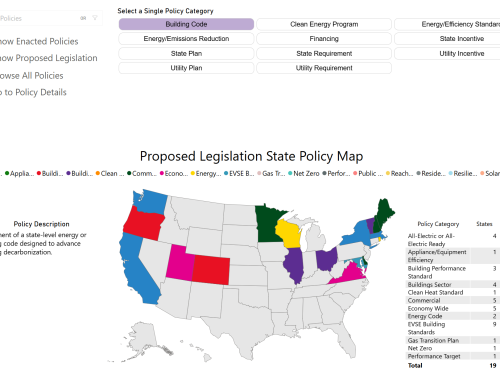
On May 7th, the U.S. Environmental Protection Agency (EPA) announced the launch of the ENERGY STAR NextGen new home certification program. This latest energy efficiency certification is a voluntary program aimed at residential new construction, developed through funding from the Inflation Reduction Act (IRA), specifically the Low emissions Electricity Program in section 60107. The program builds on over thirty years of the public-private partnership ENERGY STAR represents, compiling individual energy efficiency actions into a whole-home gold star. According to the EPA, the estimated share of new homes or apartments certified to meet existing ENERGY STAR standards ranges from under 5 percent in much of the Midwest and Southeast to between 35 and 45 percent in Arizona and Maryland.
For a new build to achieve the NextGen certification, the single- or multi-family home must have high-efficiency technologies such as multi-speed heat pumps, heat pump water heating, and electric cooktops; it must meet ENERGY STAR requirements for a well-sealed envelope; and it must have the infrastructure to support EV charging. As a result, these homes are about 20 percent more energy efficient than homes built to local building codes, resulting in pocketbook savings for the households in residence.
As of the 2020 Residential Energy Consumption Survey, there are about 31 million all-electric homes nationwide, representing about a quarter of American homes. Further, 59 percent of homes have electric-only cooktops, 46 percent have electric water heaters, and 14 percent primarily heat their homes with heat pumps. The NextGen certification requires that new homes have “advanced electric technologies” like ENERGY STAR-labeled heat pumps and heat pump water heaters, and incentivizes the installation of electric cooking appliances to reduce indoor air pollution. Altogether, the program will provide an attractive selling point for home builders to sweeten the deal for new buyers — energy efficiency with clear verification by a well-known brand.
Like with the normal dissemination of ENERGY STAR technologies, NextGen will rely on home builders, developers, contractors, and utilities to spur adoption. EPA noted that multiple home builders and utilities nationwide have begun to build to NextGen specification or offer incentives for adoption. Additionally, builders of NextGen-qualifying homes will qualify for the IRA-extended 45L Federal Tax Credit for Builders of Energy Efficient Homes.
The 45L tax credit rewards contractors or builders $2,500 for new homes that meet the traditional ENERGY STAR standards for homes and $5,000 for homes that meet the Department of Energy’s Zero Energy Ready Home (ZERH) standards.
NextGen is similar to the ZERH Program. Both are residential certification programs that require high energy efficiency verification by a third-party. Both would qualify for 45L — ZERH Program-certified homes acquired after 12/31/2022 can receive double the tax credits than only ENERGY STAR-verified homes. However, ZERH notably only requires new builds to be all-electric-ready, in that the home must have the electrical capacity to support an all-electric home but may still rely on gas appliances. In contrast, NextGen explicitly requires that homes be electrically space heated and cooled, water heated, and include electric cooking appliances.
Subsequently, the components of a NextGen home are eligible for greater federal, state, and utility incentives — this includes the 25C Residential Energy Efficiency Tax Credit, which provides up to $3,200 annually to homeowners for heat pumps or weatherization of efficiency upgrades. It also includes the Home Energy Rebates programs that are being rolled out through allocations to states and the incentives established by states and utilities to go electric.
The NextGen program is voluntary, and the monetary incentives for pursuing this specific certification are limited to a few ENERGY STAR partners such as Baltimore Gas and Electric in Maryland and Xcel Energy in Colorado and Minnesota. However, it provides a useful avenue for builders who want to serve customers who are serious about high-performance, all-electric homes. And if NextGen does get more integrated into public or private incentive structures (for example, as an additional tier of performance incentivized with a larger tax credit), it could certainly see a wider reach as builders seek to recoup their construction and installation costs.



